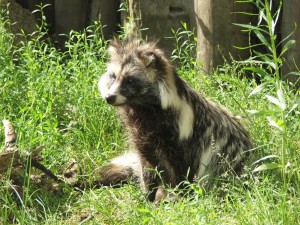 The raccoon dog emerged in the southeastern territories of the region in the 1940’s, from the adjacent Tver’ and Novgorod Regions, where it was earlier introduced. In 1941, at the dawn of WWII, several dozen raccoon dogs were set free from collective fur farms. In 1947, 80 species were introduced into the wild in the Gdov district (River Zhelcha and LakeVladychnoye). The animals acclimatized, proliferated and started to inhabit mixed and deciduous forests with bush thickets and herbaceous plants, often by some lakes, rivers and swamps. In a short while, the hunting grounds of the region had a stable game-dense populace of raccoon dogs. In 1952, raccoon dogs were yielding already 28.4% of the total value of fur procured in the region. Later the animal was listed among hunting ground pests, which resulted in a decline of the population. However, a specialized research into the nutrition of the raccoon dog proved no considerable harm was coming to the hunting economy from the species.
The raccoon dog emerged in the southeastern territories of the region in the 1940’s, from the adjacent Tver’ and Novgorod Regions, where it was earlier introduced. In 1941, at the dawn of WWII, several dozen raccoon dogs were set free from collective fur farms. In 1947, 80 species were introduced into the wild in the Gdov district (River Zhelcha and LakeVladychnoye). The animals acclimatized, proliferated and started to inhabit mixed and deciduous forests with bush thickets and herbaceous plants, often by some lakes, rivers and swamps. In a short while, the hunting grounds of the region had a stable game-dense populace of raccoon dogs. In 1952, raccoon dogs were yielding already 28.4% of the total value of fur procured in the region. Later the animal was listed among hunting ground pests, which resulted in a decline of the population. However, a specialized research into the nutrition of the raccoon dog proved no considerable harm was coming to the hunting economy from the species.
The raccoon dog is omnivorous, with the basis of its nutrition being mouse-like rodents, frogs, mollusks, and sometimes fish and insects; the plant food includes berries, acorn, and grain. It also feeds on carrion and organic waste. In the second part of November, having accumulated some fat, the species submerges into unsound dormancy. It revives in March, with the spring thaw. In the five years of 1986-1990, procurement comprised 1.5 thousand hides a year.
/ * The photos at lake.peipsi.org are cross-posted from commons.wikimedia.org and are used for familiarization purposes only. No commercial use of the photos is allowed. For more information about to use the photos see the originals on commons.wikimedia.org. /


